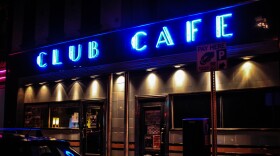In a gleeful and pun-filled ruling, the City of Pittsburgh zoning board has granted post-hoc permission to the Heinz History Center to display a giant bottle of ketchup in the front of its Strip District building.
At the center of the dispute was an argument about whether the bottle was a sign or a historical artifact. “Based on the tastefully presented evidence, the Board concludes that… the ketchup bottle installation is not a ‘sign,’” the ruling states.
The ketchup in question was a bottle of Heinz 57 that had previously sat inside Acrisure Stadium — formerly Heinz Field — pouring neon red ketchup when the Pittsburgh Steelers entered “the red zone” on the football field.
The 35-foot replica was mounted at the Museum in December such that its height exceeded the 40-foot limit set for signs in the Strip District, where the building is located. “The ketchup bottle installation has been squeezed between architectural elements of the museum building,” the decision reads.
The Public Auditorium Authority of Pittsburgh, which owns the site on which the History Center sits, did not receive zoning approval ahead of time, according to the board.
“To be frank, the Board does not relish considering legal bottlenecks where the Applicant’s anticipation of approval necessitates playing catch-up,” the ruling says, in a well-cooked lead-up to its final decision. “Any seasoned applicant should understand that post hoc applications for approvals are a big dill and could be a recipe for landing in hot sauce.”
At the center of the decision was a judgment about whether the bottle constituted an advertisement for the History Center or a historical artifact. And the zoning board ruled that it was a mere coincidence that the History Center and the bottle have the same name.
“The Heinz brand name on the bottle does not serve as a means of identification or advertising for the museum,” the ruling reads. “If the wording on the bottle included
Hunt’s’ or ‘Del Monte,’ it would be less palatable, regionally, but would be more clearly excluded from the Code’s definition of ‘sign.’”
Thus, the board concluded “the ketchup bottle is excluded from the Code’s definition of ‘sign’ and is thus not subject to the height and dimensional requirements.”
The board also noted that the ketchup bottle was very popular and no residents spoke against it. And, the board noted, that the History Center apologized for its mistake, claiming it had been unaware that the ketchup bottle presented a different kind of a zoning mess than the other historical artifacts it had previously installed.
“The Applicant laid it on thick when apologizing for acting like a hotdog when it installed the ketchup bottle without first determining what approvals might be required,” the ruling reads.













